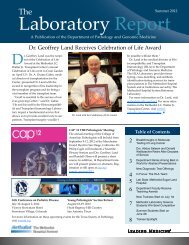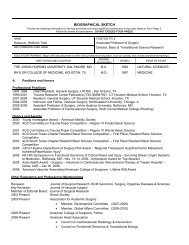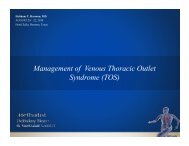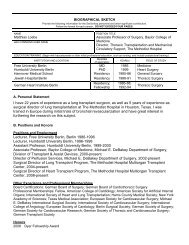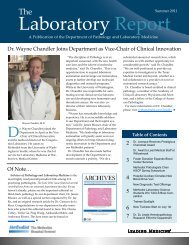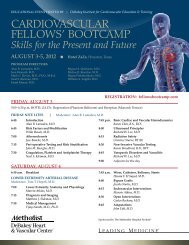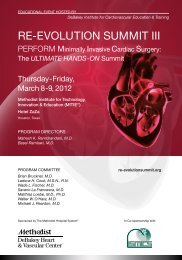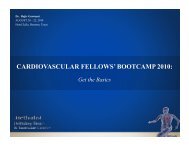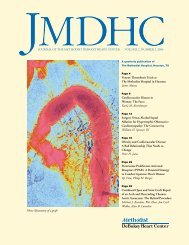DeBAKEy CARDIOvASCuLAR JOuRNAL - Methodist Hospital
DeBAKEy CARDIOvASCuLAR JOuRNAL - Methodist Hospital
DeBAKEy CARDIOvASCuLAR JOuRNAL - Methodist Hospital
You also want an ePaper? Increase the reach of your titles
YUMPU automatically turns print PDFs into web optimized ePapers that Google loves.
The <strong>Methodist</strong> <strong>Hospital</strong><br />
chosen for percutaneous<br />
valve replacement study<br />
Study evaluates replacing<br />
heart valve through tiny<br />
puncture hole<br />
MetHodist de Bakey Heart & VasCular Center update<br />
HOuSTON (Jan. 24, 2011) —<br />
The <strong>Methodist</strong> DeBakey Heart &<br />
vascular Center was chosen today<br />
as a site for a critical percutaneous<br />
heart valve study. As part of the<br />
research study, <strong>Methodist</strong> physicians<br />
will replace diseased cardiac<br />
valves through a single, tiny puncture<br />
hole in the research subject’s<br />
groin.<br />
“using this new technique in the<br />
study, we will be able to replace<br />
severely calcified and damaged<br />
aortic valves without open heart<br />
surgery or removal of the original<br />
diseased valve,” said Dr. Neal<br />
Kleiman, director of the catheterization<br />
labs at the <strong>Methodist</strong><br />
DeBakey Heart & vascular Center<br />
and cardiology principal investigator<br />
for the trial. “This study is the<br />
only way individuals have access<br />
to this technique in the united<br />
States.”<br />
The Medtronic Corevalve ®<br />
System, which is delivered into<br />
the individual’s heart via catheter,<br />
has been implanted in more than<br />
12,000 patients worldwide and is<br />
available in 34 countries outside<br />
the united States.<br />
The trial incorporates expertise<br />
of both cardiac surgeons and cardiologists.<br />
using this technique,<br />
physicians make a tiny puncture<br />
hole in the individual’s groin and<br />
In the news<br />
thread a catheter through the<br />
femoral artery into the heart. The<br />
valve is delivered to the site of the<br />
diseased aortic valve through the<br />
catheter, and then the new valve<br />
is deployed inside the individual’s<br />
original valve, thus providing the<br />
individual with a functioning valve<br />
to allow for effective blood flow.<br />
“We routinely perform surgical<br />
valve replacement for diseased<br />
aortic valves, but many individuals<br />
are too high a risk for open-heart<br />
surgery due to age or other illness,<br />
said Dr. Michael Reardon, cardiac<br />
surgeon at <strong>Methodist</strong> and surgical<br />
principal investigator for the<br />
trial. “In this trial, we will evaluate<br />
whether catheter based aortic valve<br />
replacement will help extend the<br />
lives of this group of individuals.”<br />
Worldwide, approximately<br />
300,000 people have been diagnosed<br />
with this condition (100,000<br />
in the united States), and approximately<br />
one-third of these patients<br />
are deemed at too high a risk for<br />
open-heart surgery,[i] the only therapy<br />
with significant clinical effect<br />
that is currently available in the<br />
united States.<br />
Traditionally, a valve is replaced<br />
with a tissue or mechanical valve<br />
during open-heart surgery, which<br />
requires a surgical incision and<br />
a one month recovery period.<br />
Transcatheter valve replacement<br />
is being studied in part to evaluate<br />
recovery times and exposure to<br />
side affects of major surgery.<br />
In July, <strong>Methodist</strong> opened a new<br />
hybrid, robotic operating suite that<br />
integrates advanced robotics, imag-<br />
ing and navigation with surgery to<br />
offer patients the least invasive and<br />
safest surgical and interventional<br />
treatments for cardiovascular disease.<br />
“The new suite is perfectly<br />
designed for advanced procedures<br />
like the percutaneous valve,” said<br />
Dr. Alan Lumsden, medical director<br />
of the <strong>Methodist</strong> DeBakey<br />
Heart & vascular Center in<br />
Houston. “The clear 3-D imaging<br />
we have in this new room enables<br />
us to maneuver the valve into<br />
place and position it much more<br />
accurately and precisely than ever<br />
before. This is vitally important in<br />
such an advanced technique.”<br />
<strong>Methodist</strong> will be one of 40 sites<br />
in the country studying this new<br />
technique. The study investigators<br />
are currently screening subjects for<br />
enrollment. <strong>Methodist</strong> will enroll<br />
approximately 100 patients over the<br />
course of the trial. The Medtronic<br />
Corevalve u.S. Pivotal Clinical<br />
Trial will enroll a total of more<br />
than 1,300 patients in the united<br />
States. Outside the united States,<br />
Corevalve received CE (Conformité<br />
Européenne) Mark in Europe in<br />
2007.<br />
For more information on the<br />
<strong>Methodist</strong> DeBakey Heart &<br />
vascular Center, visit www.<br />
debakeyheartcenter.com.<br />
[i] Iung B, Cachier A, Baron G, et al.<br />
Decision-making in elderly patients<br />
with severe aortic stenosis: why are<br />
so many denied surgery? Eur Heart J.<br />
2003;26:2714-2720.<br />
56 vII (1) 2011 | MDCvJ



